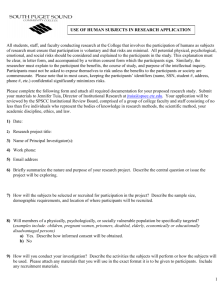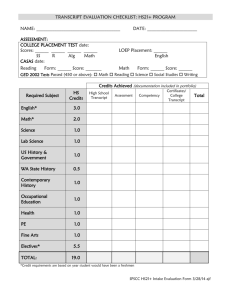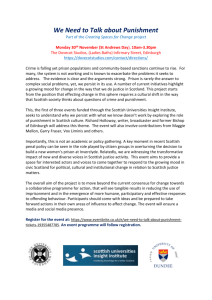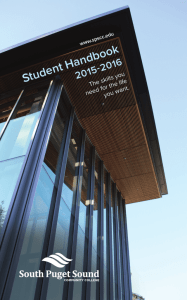Scottish Government Population Survey Co
advertisement
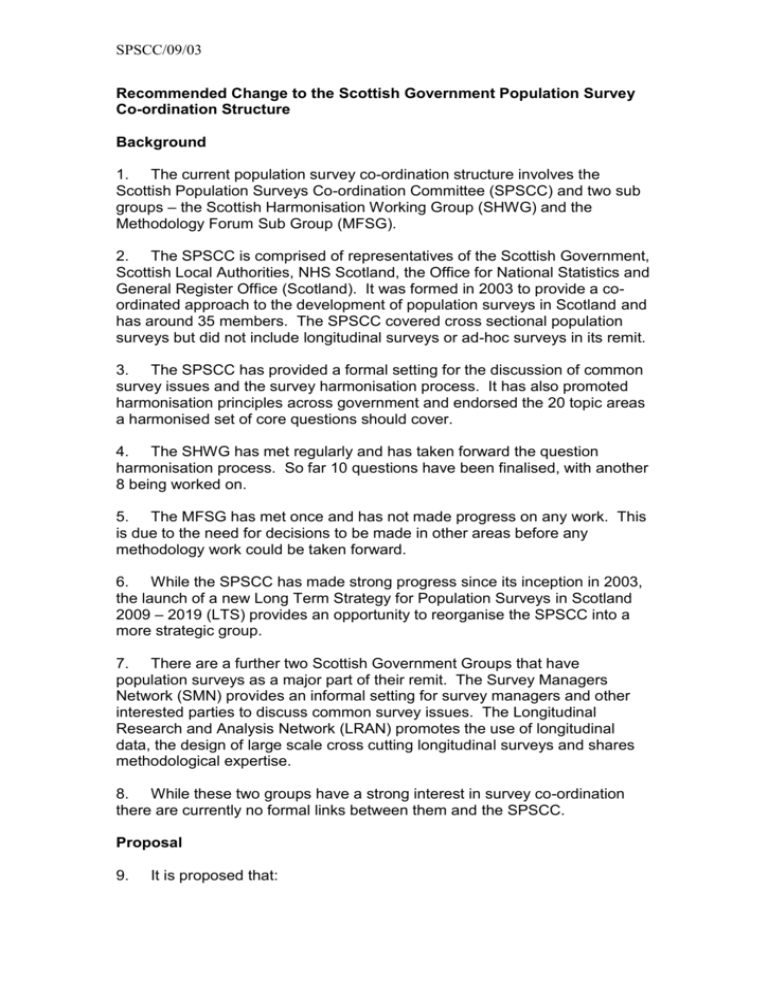
SPSCC/09/03 Recommended Change to the Scottish Government Population Survey Co-ordination Structure Background 1. The current population survey co-ordination structure involves the Scottish Population Surveys Co-ordination Committee (SPSCC) and two sub groups – the Scottish Harmonisation Working Group (SHWG) and the Methodology Forum Sub Group (MFSG). 2. The SPSCC is comprised of representatives of the Scottish Government, Scottish Local Authorities, NHS Scotland, the Office for National Statistics and General Register Office (Scotland). It was formed in 2003 to provide a coordinated approach to the development of population surveys in Scotland and has around 35 members. The SPSCC covered cross sectional population surveys but did not include longitudinal surveys or ad-hoc surveys in its remit. 3. The SPSCC has provided a formal setting for the discussion of common survey issues and the survey harmonisation process. It has also promoted harmonisation principles across government and endorsed the 20 topic areas a harmonised set of core questions should cover. 4. The SHWG has met regularly and has taken forward the question harmonisation process. So far 10 questions have been finalised, with another 8 being worked on. 5. The MFSG has met once and has not made progress on any work. This is due to the need for decisions to be made in other areas before any methodology work could be taken forward. 6. While the SPSCC has made strong progress since its inception in 2003, the launch of a new Long Term Strategy for Population Surveys in Scotland 2009 – 2019 (LTS) provides an opportunity to reorganise the SPSCC into a more strategic group. 7. There are a further two Scottish Government Groups that have population surveys as a major part of their remit. The Survey Managers Network (SMN) provides an informal setting for survey managers and other interested parties to discuss common survey issues. The Longitudinal Research and Analysis Network (LRAN) promotes the use of longitudinal data, the design of large scale cross cutting longitudinal surveys and shares methodological expertise. 8. While these two groups have a strong interest in survey co-ordination there are currently no formal links between them and the SPSCC. Proposal 9. It is proposed that: SPSCC/09/03 a. the SPSCC is retained as a strategic group responsible for delivery of the LTS. b. the MFSG is merged with the SHWG to form an operational group to take the LTS forward. c. the links between the SPSCC and the SMN and LRAN are formally recognised in the revised structure. 10. A chart illustrating the proposed structure is in Annex 1. Scottish Population Surveys Co-ordinating Committee 11. The membership of the SPSCC would be substantially reduced. This will allow a more streamlined approach to decision making and a more focussed approach to the LTS. 12. The membership of the SPSCC would be: Chief Statistician Chief Researcher Secretary SHWG Chair 1 GROS Rep 1 ONS Rep 1 LRAN Rep 1 Local Authority Rep 1 SMN Rep* Rob Wishart Diana Wilkinson Sara Grainger Alex Stannard (to be nominated by GROS) (to be nominated by ONS) (to be nominated by LRAN) (to be nominated by COSLA/Improvement Service) (to be nominated by SMN) *The SMN would attend as a permanent ‘guest’ member. They would feed information into the SPSCC but would not be a ‘voting’ member when decisions are made. 13. The SPSCC would agree the work plan of the SHWG and would receive updates from the SHWG at each meeting. 14. LRAN membership of the SPSCC would ensure the importance of longitudinal research is reflected in the structure and would allow longitudinal research analysts to feed into the decision making. LRAN would provide an update to the SPSCC at each meeting and the SPSCC would be able to feed into the LRAN work plan. 15. There has been concern in the past that some issues regularly discussed at SMN were not actioned as they were outside the remit of the group. SMN membership of the SPSCC would allow the SMN to feed issues upwards for consideration at the SPSCC. 16. The SPSCC would receive updates from the SMN if they attended but would have no power to direct the work of the SMN. SPSCC/09/03 17. There was some concern that if the SMN has a seat on the SPSCC that this might affect SMN’s remit. But the structure is clear that the SPSCC cannot guide the work of the SMN. However, to ensure the structure operates as intended it is proposed that SMN membership of the SPSCC is reviewed after one year. In addition, if SMN was excluded, the membership of the SPSCC would not include survey managers and there would be no direct link between survey managers and the SPSCC. 18. It has also been suggested that Directors or policy colleagues from the areas that fund major surveys should also be included, to ensure support from budget holders and policy engagement. However, it is likely the SPSCC’s work would be too detailed to be of interest to Directors and policy colleagues and an expanded SPSCC may lose its strategic focus. 19. It is proposed the SPSCC would meet twice a year and that the chair would rotate between the Chief Statistician and Chief Researcher. Scottish Harmonisation Working Group 20. The SHWG would retain its current membership and would be chaired by the Survey Harmonisation Co-ordinator. It would take forward the work plan agreed by the SPSCC. Its remit would be widened to include the methodology work currently in the remit of the MFSG. The MFSG would be abolished. 21. This widened remit of the SHWG would include finalising the harmonised questions, standardising survey procedures (such as consent forms and dissemination) and overseeing the methodological work to pool samples. The groups name would change to the Scottish Population Surveys Working Group. 22. There was some concern that this remit would be too wide for a single group, so it is recommended the group and remit be reviewed after a year. 23. There are no proposals to change the remit or membership of the SMN or LRAN. Recommendation 24. It is recommended the SPSCC approves the new Population Survey Coordination Structure set out in this paper. Alex Stannard Office of the Chief Statistician April 2009 SPSCC/09/03 Annex A – Proposed Scottish Population Surveys Co-ordinating Structure Survey Managers Network Remit: Open forum for sharing survey best practice Chair: Helen Fogarty Scottish Population Surveys Coordination Committee Remit: Steer delivery of the Long Term Strategy for Population Surveys in Scotland 2009 – 2019. Longitudinal Research and Analysis Network Remit: Promote longitudinal research Chair: Chief Researcher Membership: Scottish Government survey managers and others interested in survey management Chair: Rotating Chief Statistician/Chief Researcher Membership: Chief Statistician, Chief Researcher, Secretary, and one representative each from: SPSWG, GROS, ONS, COSLA/IS, SMN and LRAN. Scottish Population Surveys Working Group (SPSWG) Remit: Agree harmonised questions, standardise survey procedures, oversee methodological work to pool samples. Chair: Survey Harmonisation Co-ordinator Membership: Scottish Government population survey managers Membership: Open to all with an involvement in longitudinal research.

